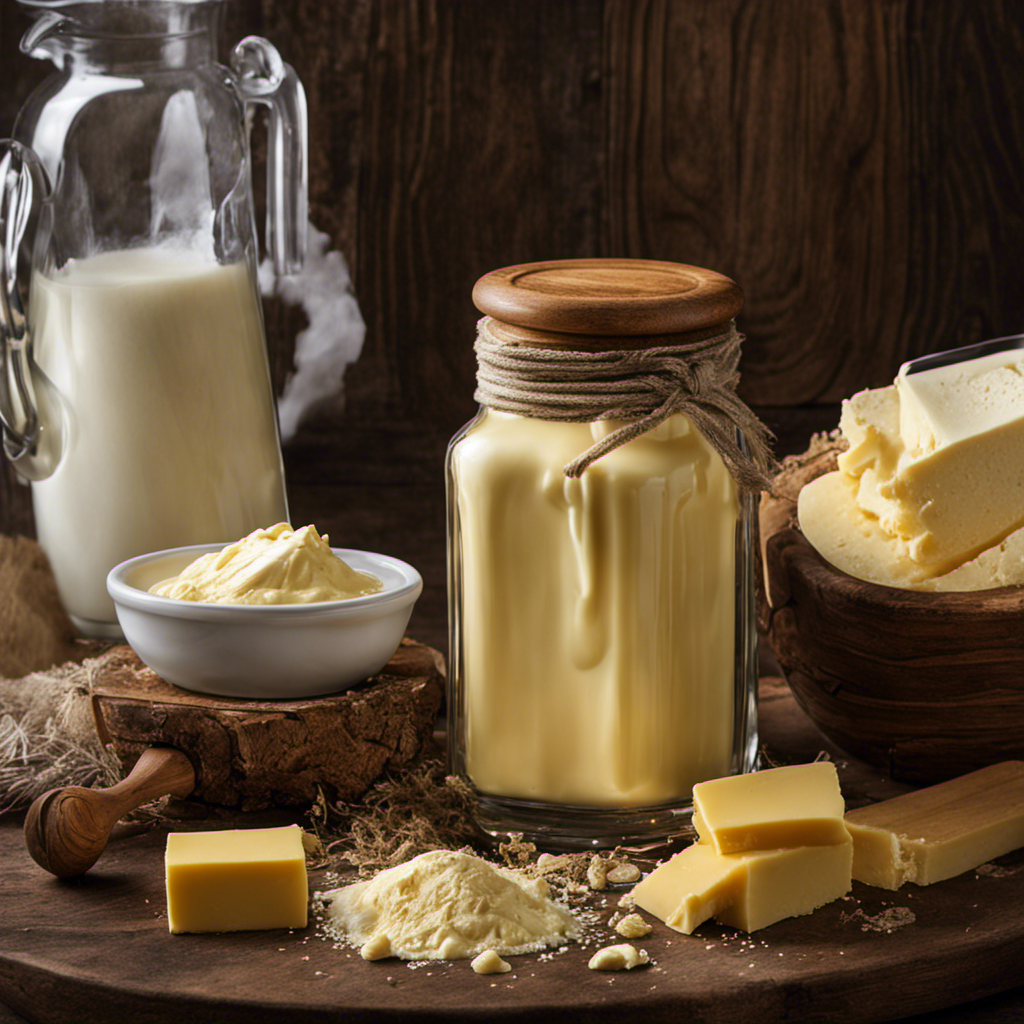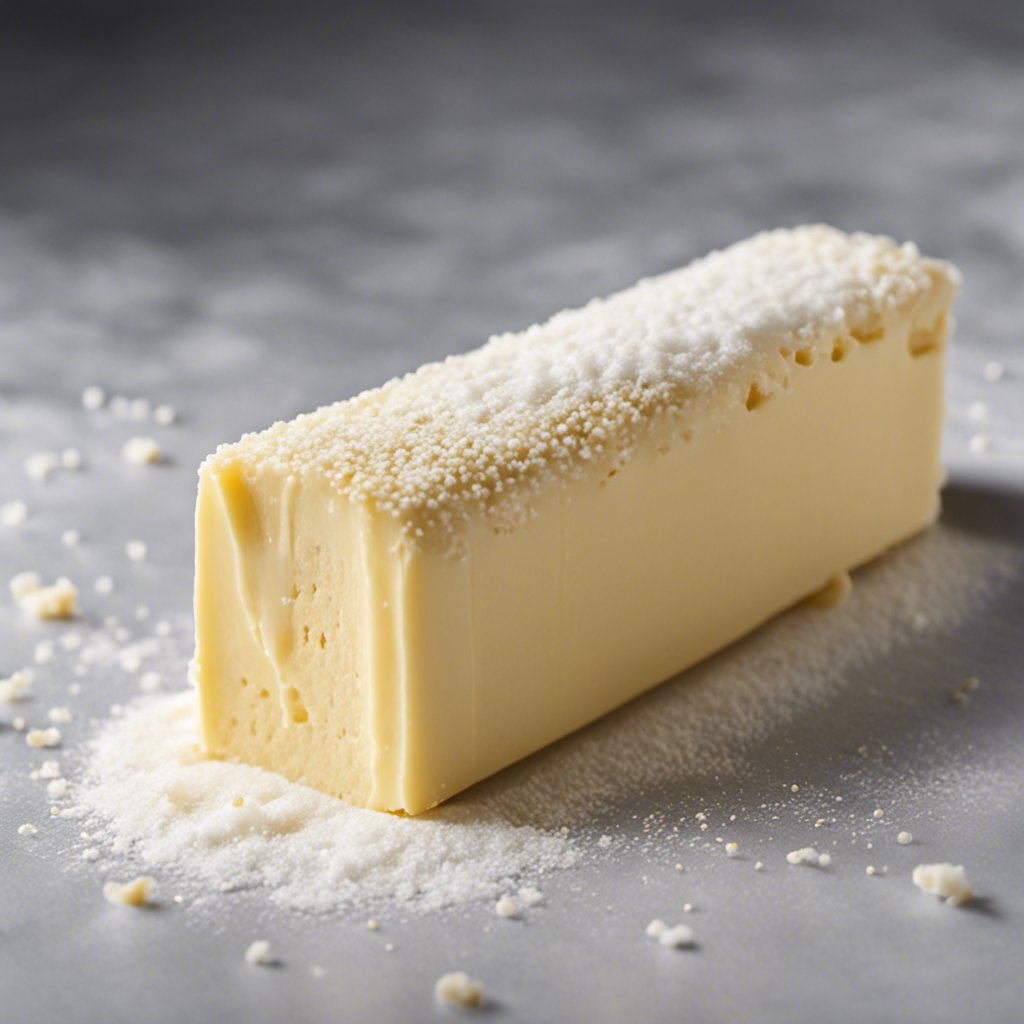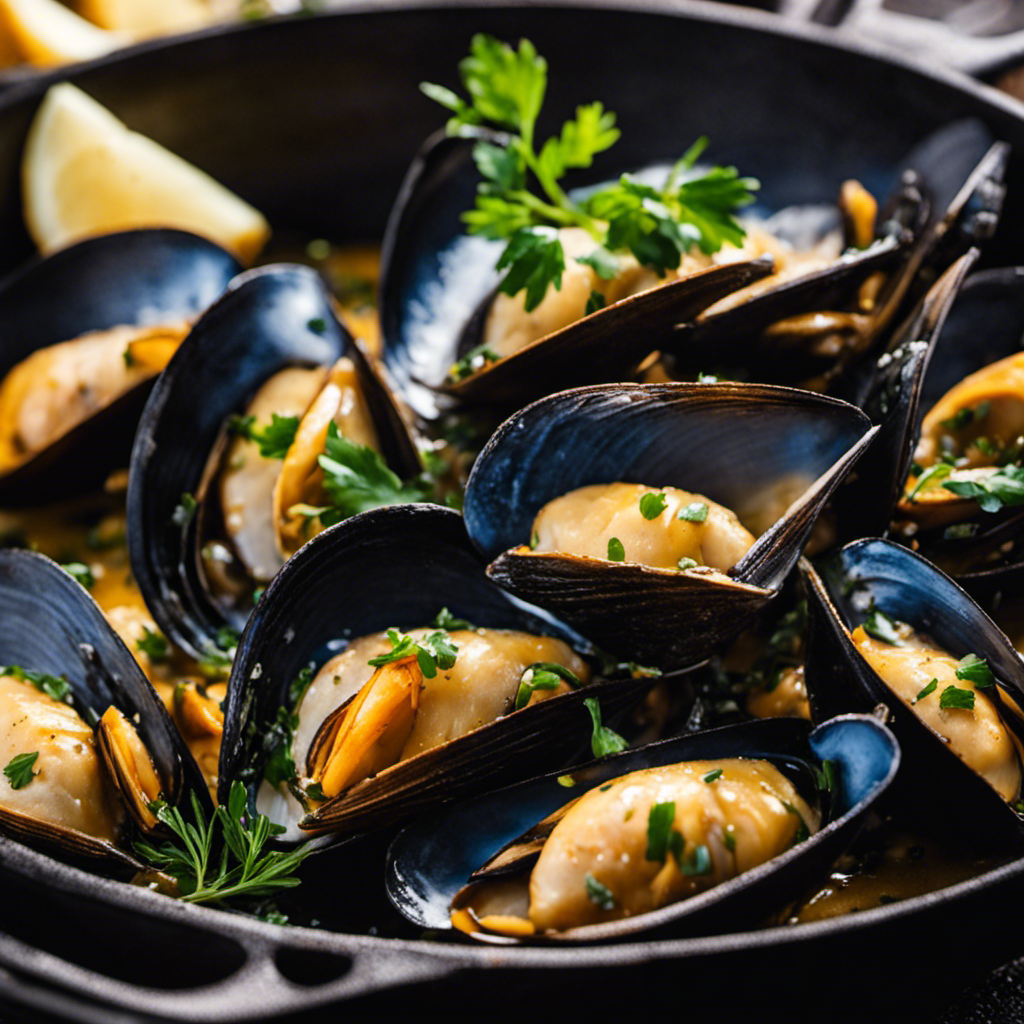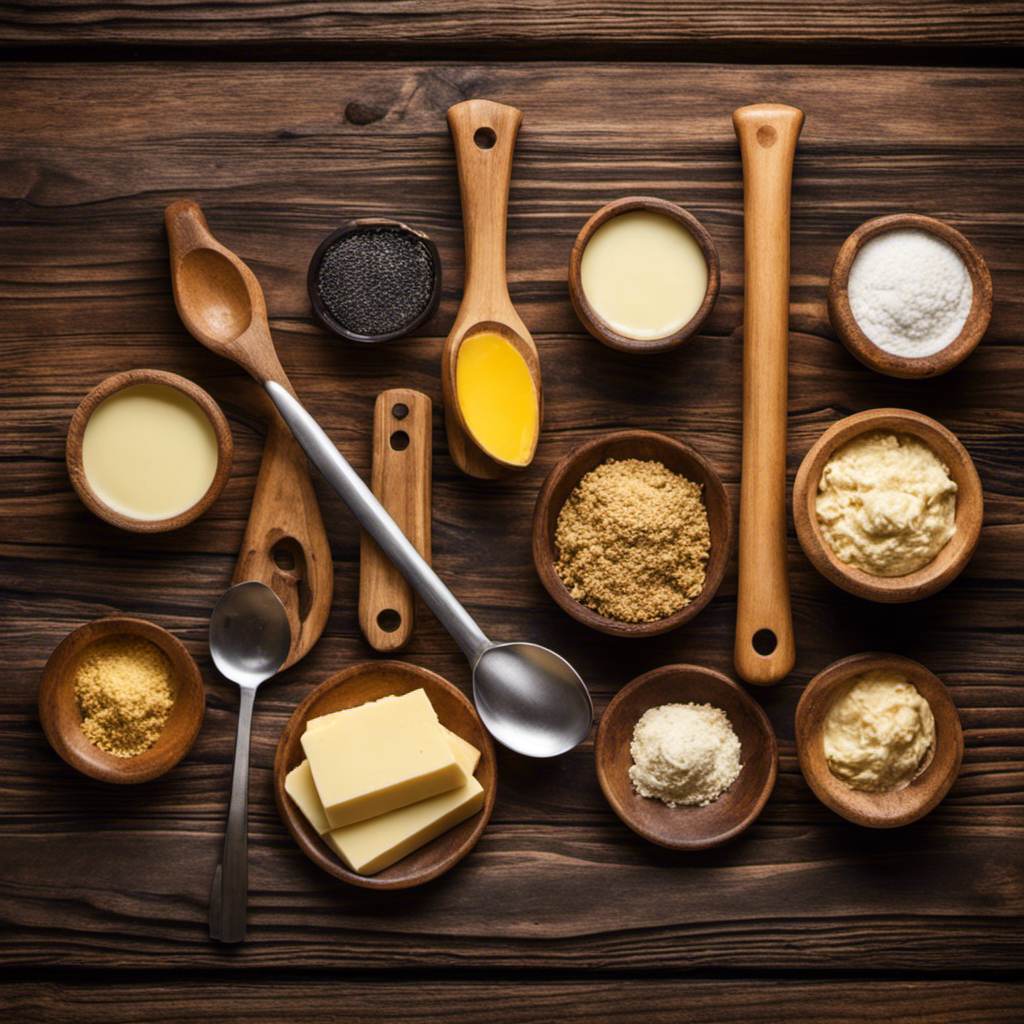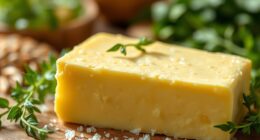The process of creating butter has always captivated me. It’s incredible to witness how just a quart of cream can evolve into something incredibly tasty and adaptable.
But just how much butter can you expect to get from that quart of cream? In this article, we’ll explore the cream to butter ratio and guide you through the step-by-step process of churning cream.
We’ll also discuss factors that can affect butter yield and share tips for maximizing butter extraction. So grab your apron and let’s dive into the world of homemade butter!
Key Takeaways
- Making butter involves churning cream until it separates into butter and buttermilk.
- The cream to butter ratio is about 4:1, meaning a quart of cream yields around 1 pound of butter.
- Factors such as cream fat content and churning temperature affect butter yield and quality.
- Using the right equipment, such as a churn or stand mixer, and selecting fresh cream are important for successful churning.
The Basics of Butter Making
Making butter is a simple process that involves churning cream until it separates into butter and buttermilk. Cream separation is the key step in this process.
When cream is left to sit, the fat molecules rise to the top, creating a layer of cream. This cream is then collected and churned, either by hand or using a machine. The churning action causes the fat molecules to clump together, forming butter.
As the churning continues, the fat separates from the liquid, which is the buttermilk. The consistency of the butter depends on how long you churn it. If you stop churning when the butter has just formed, it will be soft and spreadable. But if you continue churning, the butter will become firmer and more solid.
Understanding the Cream to Butter Ratio
To understand the cream to butter ratio, you’ll need to know how to measure the amount of cream you have. The ratio refers to the amount of butter that can be obtained from a given quantity of cream.
There are various butter extraction techniques, but the most common is churning. Churning involves agitating the cream until it separates into butter and buttermilk. The ratio can vary depending on factors such as the fat content of the cream and the churning method used.
On average, a quart of cream can yield around 1 pound of butter, resulting in a ratio of 4:1. However, it’s important to note that the ratio may differ slightly based on individual circumstances and preferences.
Step-by-Step Guide to Churning Cream
I want to discuss the process of making butter and provide some tips for successful churning.
First, I will explain the butter-making process, including the separation of cream from milk and the agitation required to transform the cream into butter.
Then, I will provide helpful tips for achieving successful churning, such as using cold cream, maintaining consistent agitation, and monitoring the temperature.
Butter-Making Process Explained
You’ll be surprised at how much butter you can make from a quart of cream. The science of butter making is fascinating, and understanding the process can help you avoid common mistakes. Here’s what you need to know:
-
Separating the cream: Start by allowing the cream to settle in the fridge for a few hours. This will help the fat rise to the top, making it easier to separate from the liquid.
-
Churning the cream: Pour the cream into a churn or a mason jar and start shaking vigorously. The fat globules in the cream will begin to clump together, forming butter.
-
Washing the butter: Once the butter is formed, drain off the liquid (buttermilk) and rinse the butter under cold water. This helps remove excess buttermilk and prevents spoilage.
-
Storing the butter: Pack the butter into a container, making sure to remove any remaining liquid. Store it in the refrigerator to keep it fresh.
Understanding the butter-making process is key to successful churning. Now, let’s move on to some tips for achieving the best results.
Tips for Successful Churning
Understanding the science behind butter making can lead to more successful churning. When it comes to churning equipment, using a churn with a paddle attachment or a stand mixer with a whisk attachment is recommended for best results. These tools help to agitate the cream and separate the fat from the liquid.
As for cream types, heavy cream or whipping cream with a high butterfat content (at least 35%) is ideal for making butter. The higher the fat content, the easier it is to achieve a higher butter yield. Additionally, using cream that is fresh and not overly pasteurized can also improve the churning process.
By selecting the right equipment and cream types, you can maximize your chances of obtaining a higher butter yield.
Now, let’s explore the factors that can affect butter yield in more detail.
Factors Affecting Butter Yield
When it comes to churning cream, there are two key factors that can significantly impact the butter yield: cream fat content and churning temperature.
The fat content of the cream will determine how much butter can be produced from a given amount. Additionally, the temperature at which the cream is churned can affect the efficiency of the churning process and the final texture of the butter.
Understanding and controlling these factors is essential for achieving optimal butter yield and quality.
Cream Fat Content
To determine the fat content of the cream, you can simply check the nutrition label or refer to the product packaging. Knowing the cream’s fat content is crucial in butter production, as it directly affects the yield and quality of the butter.
Here are four key points about cream fat content and its role in butter production:
-
Fat content: Cream with higher fat content, typically ranging from 30% to 40%, is ideal for butter production.
-
Churning process: The fat globules in the cream are agitated during churning, causing them to clump together and separate from the liquid portion.
-
Butter yield: The higher the fat content of the cream, the more butter can be obtained from a given quantity.
-
Butter quality: Cream with higher fat content results in butter with a richer flavor, smoother texture, and better spreadability.
Understanding the cream’s fat content is essential for achieving optimal results in butter production.
Churning Temperature
The churning temperature greatly affects the texture and consistency of the resulting product. When it comes to making butter, the temperature at which the cream is churned plays a crucial role.
Churning equipment, such as a butter churn or a stand mixer with a whisk attachment, can be used to agitate the cream and separate the butterfat from the liquid. The ideal churning temperature is around 50 to 55°F (10 to 13°C).
If the temperature is too cold, the butterfat may not separate properly, resulting in a softer and less consistent butter. On the other hand, if the temperature is too warm, the butter may become too soft and lose its structure.
Therefore, maintaining the correct churning temperature is essential in achieving the desired butter consistency.
Tips for Maximizing Butter Extraction
One way to maximize butter extraction is by chilling your cream before churning it. This helps to solidify the fat and separate it from the liquid, resulting in a higher yield of butter.
Here are some tips for maximizing butter extraction:
-
Use high-quality cream: Starting with a good quality cream will ensure a rich and flavorful butter.
-
Optimal churning temperature: Find the ideal temperature for churning based on the type of butter making equipment you are using.
-
Allow cream to ripen: Letting the cream sit at room temperature for a few hours before chilling can enhance the flavor and increase butter extraction.
-
Properly wash and drain the butter: Thoroughly washing and draining the butter after churning helps remove any remaining liquid and improves its texture.
Different Methods for Making Butter From Cream
If you’re unsure which method to use, try researching different ways to make butter from cream. There are various types of cream that can be used to make butter, such as heavy cream or whipping cream. The type of cream you choose will affect the final taste and texture of the butter.
Additionally, there are different tools that can be used to churn the cream into butter. Traditional methods involve using a butter churn or a jar with a tight-fitting lid, while modern methods may include using a stand mixer or a food processor. Experimenting with different types of cream and tools can help you find the method that works best for you.
Now, let’s move on to how to store homemade butter.
How to Store Homemade Butter
After making homemade butter from cream, it’s important to know how to properly store it to maintain its freshness and flavor. Here are some effective butter storage techniques:
-
Refrigeration: Place the homemade butter in an airtight container and store it in the refrigerator. This will help preserve its texture and prevent it from spoiling quickly.
-
Freezing: If you have a large batch of homemade butter, freezing it is a great option. Wrap the butter tightly in plastic wrap or place it in a freezer-safe container to prevent freezer burn.
-
Flavored Butter: To add variety to your butter, consider making flavored butter. Mix in herbs, spices, or even garlic to create delicious spreads. Store flavored butter in the refrigerator or freezer to maintain its freshness.
-
Butter Bell: A traditional method for storing butter is using a butter bell. This unique container keeps the butter soft and spreadable without refrigeration. Simply add cold water to the base and place the butter inside the lid.
Delicious Recipes Using Homemade Butter
When storing your homemade butter, it’s important to consider delicious recipes that can incorporate this flavorful ingredient. From savory spreads to decadent desserts, there are endless possibilities to explore. Here are some mouthwatering ideas to make the most of your homemade butter:
| Delicious Butter Spreads | Butter Based Desserts |
|---|---|
| Garlic Herb Butter | Butter Pecan Cookies |
| Sundried Tomato Butter | Buttercream Frosting |
| Honey Cinnamon Butter | Butter Tart |
These spreads can be slathered on warm bread or used as a tasty topping for grilled meats. As for the desserts, the rich and creamy texture of homemade butter adds a delightful twist to classic treats. Whether it’s cookies, frosting, or tarts, the possibilities are endless. So, don’t let your homemade butter go to waste – get creative in the kitchen and enjoy these delicious butter-infused recipes.
Troubleshooting Butter Making Issues
To troubleshoot any issues you may encounter while making your own butter, try adjusting the temperature and mixing time.
Here are some common problems you might face and how to solve them:
-
Grainy Texture: If your butter turns out grainy, it could be due to over-churning. Reduce the mixing time to achieve a smoother texture.
-
Soft Butter: If your butter is too soft and doesn’t hold its shape, it may not have been chilled enough. Make sure to refrigerate the cream for a sufficient amount of time before churning.
-
Separation: If your butter and buttermilk separate during the churning process, it could be because the cream was too warm. Try lowering the temperature to prevent separation.
-
Equipment Problems: If your butter doesn’t form properly, check your equipment. Ensure that your churn is clean and in good condition, and that your cream is fresh.
Frequently Asked Questions
Can I Use Any Type of Cream to Make Butter?
I can use any type of cream to make butter. However, there is a difference between using heavy cream and light cream. Heavy cream has a higher fat content, which results in a richer and creamier butter.
How Long Does It Typically Take to Churn Cream Into Butter?
To speed up the butter churning process, here are a few tips I’ve found helpful. First, make sure the cream is at room temperature. Second, use a hand mixer for faster results. Lastly, be patient and keep churning until the butter becomes smooth and creamy.
Can I Use a Blender or Food Processor Instead of a Churn to Make Butter?
Using a blender or food processor to make butter has its pros and cons. While it can be quicker, it may not yield the same texture as using a churn. Experimentation is key.
What Are Some Common Reasons Why Butter Making May Fail?
When it comes to making butter, there are common mistakes that can derail the process. Troubleshooting the butter making process is essential to ensure a successful outcome.
How Long Can Homemade Butter Be Stored Before It Goes Bad?
Homemade butter can be stored for up to two weeks in the refrigerator. To ensure its shelf life, store it in an airtight container and keep it away from strong odors.
Conclusion
In conclusion, making butter from cream is a simple and rewarding process. By understanding the cream to butter ratio and following a step-by-step guide, you can easily churn your own butter at home.
One interesting statistic to note is that on average, a quart of cream can yield about one pound of butter. This means that with just a single quart of cream, you can enjoy a generous amount of homemade butter to enhance your culinary creations.
So why not give it a try and elevate your cooking to a whole new level?
